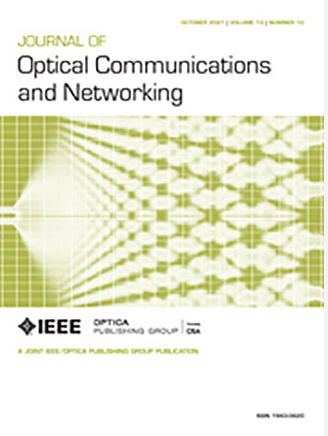纵向功率分布监测遥测实现自修复光网络
IF 4.3
2区 计算机科学
Q1 COMPUTER SCIENCE, HARDWARE & ARCHITECTURE
引用次数: 0
摘要
光网络中的软故障是一个巨大的挑战,因为它们的检测和定位是众所周知的困难。这通常导致在确定根本原因之前就实施了次优缓解策略。为了解决这一问题,纵向功率监测技术近年来得到了广泛的关注。LPM利用来自相干接收器的信息来计算光路上的功率演化。本文提出了一种集成从接收端获取的功率分布信息和SDN控制器的架构。其结果是一个自我修复的光网络,能够定位其光路中的软故障,并提供精细调整的重新配置来解决它们。通过开发符合openconfig的YANG模型,我们实现了gNMI流机制,每1.5秒从接收器向SDN控制器发送功率配置指标。该过程利用两个SDN应用程序,将控制器接收到的数据结合起来,最终确定功率分布计算并查明软故障的位置。该体系结构的有效性通过两个场景来证明。在第一个场景中,SDN控制器准确地识别和解决由沿跨度战略性放置的voa引起的衰减。在第二种情况下,控制器联合检查两条光路的功率分布图,以定位导致其中一条光路衰减的故障WSS。本文章由计算机程序翻译,如有差异,请以英文原文为准。
Longitudinal power profile monitoring telemetry enabling self-healing optical networks
Soft failures in optical networks pose a significant challenge, as their detection and localization are notoriously difficult. This often leads to suboptimal mitigation strategies being implemented before the root cause is identified. To address this, the longitudinal power monitoring (LPM) technique has gained significant attention in recent years. LPM leverages information from the coherent receiver to compute the power evolution along the optical path. This paper presents an architecture that integrates the power profile information retrieved from the receiver with the SDN controller. The result is a self-healing optical network capable of locating soft failures in its lightpaths and providing finely tuned reconfigurations to solve them. By developing an OpenConfig-compliant YANG model, we implemented a gNMI streaming mechanism to transmit power profile metrics every 1.5 s from the receiver to the SDN controller. This process utilizes two SDN applications that combine the received data at the controller to finalize the power profile computation and pinpoint the location of soft failures. The architecture’s effectiveness is demonstrated through two scenarios. In the first scenario, the SDN controller accurately identifies and resolves attenuation caused by VOAs strategically placed along a span. In the second scenario, the controller jointly examines the power profiles of two lightpaths to locate a faulty WSS that is causing attenuation in only one of them.
求助全文
通过发布文献求助,成功后即可免费获取论文全文。
去求助
来源期刊
CiteScore
9.40
自引率
16.00%
发文量
104
审稿时长
4 months
期刊介绍:
The scope of the Journal includes advances in the state-of-the-art of optical networking science, technology, and engineering. Both theoretical contributions (including new techniques, concepts, analyses, and economic studies) and practical contributions (including optical networking experiments, prototypes, and new applications) are encouraged. Subareas of interest include the architecture and design of optical networks, optical network survivability and security, software-defined optical networking, elastic optical networks, data and control plane advances, network management related innovation, and optical access networks. Enabling technologies and their applications are suitable topics only if the results are shown to directly impact optical networking beyond simple point-to-point networks.

 求助内容:
求助内容: 应助结果提醒方式:
应助结果提醒方式:


